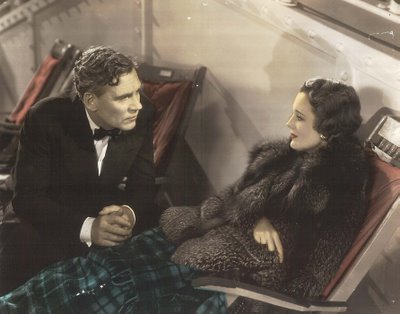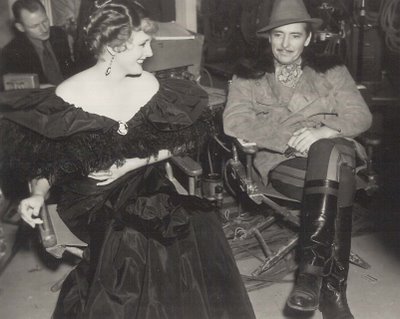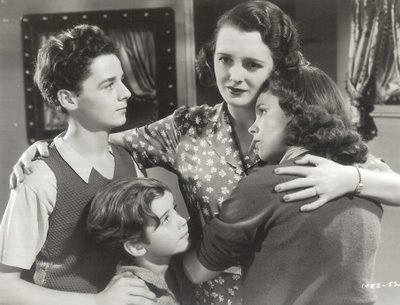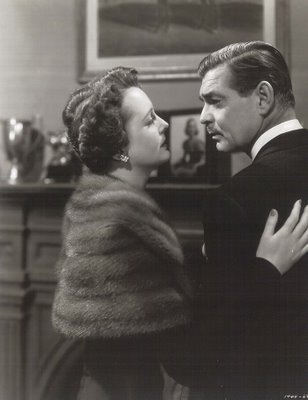

Mary Astor --- Part Two
The diary scandal that enveloped Mary Astor in 1936 might have derailed her career just as a similar incident damaged Clara Bow a few years earlier, but tabloid readers allowed some leeway for an actress who’d never pretended to be something she wasn’t. Featured player status had come to her rescue, for a truly prominent name, hamstrung with those expectations stardom conferred, would surely have gone down in flames. It’s one thing being accused of adultery by an estranged husband … another to have your own detailed account of the affair splashed all over the press. Hubby’s idea in waving the purloined diary was to blackmail Astor into submission with regards the contested custody of their daughter, but the actress instead took the stand and let the chips fall where they may. Tab editors had to blip her explicit exhalations over paramour George S. Kaufman’s boudoir supremacy, leaving readers to fill in various blanked out words from sentences she’d supposedly written. If excerpts contained in Kenneth Anger’s 1975 collection (Hollywood Babylon) are to be believed (and there’s plenty of reason they shouldn’t), Mary Astor was indeed still water that ran very deep. Considering the sort of best-seller reception Anger’s book received, at a time when many of the personages he covered were still alive, I’d venture to say that diary was talked about almost as much forty years after the fact as it was in 1936 (since 1975 was presumably the first occasion on which those excerpts were published in unexpurgated form). By then, Mary Astor was a resident at the Motion Picture Country House. It would be interesting to know what her reaction was when the book was doubtlessly mentioned, if not shown, to her.


Dodsworth was in production when the divorce went to trial, and as this was Astor’s favorite of all her screen roles, she merely went into the character for purposes of testifying. If her performance on the stand was a tenth as effective as what we saw in the movie, then it’s no wonder she wound up with both the kid and the house. Free-lancing was a mixed bag. She’d go to see movies starring Irene Dunne and envy that actress the better parts she got, but there were compensations. The Prisoner Of Zenda found Astor far more engaging than putative lead Madeleine Carroll, but The Hurricane was a hellish ordeal, thanks to a disaster finale that nearly swept away the ensemble cast. Three years later, it was crickets swarming over her in Brigham Young --- Frontiersman, where she was the most visible of the title character’s multiple wives. The real transition came with Listen, Darling, as it was here that Astor’s mould was poured and set in stone at Metro --- she’d seemingly play mother to every dewy hopeful on the lot. The MGM contract promised a steady check for forty weeks out of the year. All she had to do was show up and play the same part ad nauseum. Side-trips to Warners were more rewarding. The Great Lie won her the Academy Award for Best Supporting Actress. Bette Davis virtually rewrote the show to Astor’s advantage, knowing that to hog the limelight on this occasion would further diminish an already weak product. Both actresses benefited from the arrangement, and Astor became another who would speak highly of B.D. in later years. The Maltese Falcon inspires less consensus, at least among viewers I’ve spoken with. Mary Astor was miscast as the double-dealing murderess … She’s not believable … The weakest link in an otherwise unbroken chain of great performances. I just watched it again a couple weeks ago, and I’m OK with Astor in this part. Maybe after forty years I’m used to her, and besides, what’s the point of recasting a thing so very nearly perfect to begin with? She certainly brings gravity to the role quite beyond the capabilities of a younger actress, even though she was only thirty-five when The Maltese Falcon was made.




The Mothers For Metro rut wasn’t entirely unrewarding, for there was at least Meet Me In St. Louis, the sort of movie cast members could dine out on for the rest of their lives (but what’s ever become of Joan Carroll, who played Agnes?). Mary Astor was less patient now with on-set pranksters and bratty kids. A Life On Film relates her impatience with Margaret O’Brien, who made life miserable for crewmembers in general and propmasters in particular. Judy Garland was also told off in no uncertain terms by the veteran actress when she held up production. It could be that Astor was bristling over the sameness of these enterprises, for St. Louis excepted, it did seem she was carrying the same maternal spear time and again. Alcohol provided a temporary out --- well, playing mother to those 1949 Little Women might send any performer on a quest for the bottle. Trouble is, the spirits took their toll on hers, and age began to tell. Astor was but forty-one and sparring with screen daughter Lizabeth Scott in Desert Fury, and though it was better work than she getting at Metro, there was no escaping the typecast she’d locked herself into. The best evidence of what those years had done was provided in Any Number Can Play, wherein Astor’s character cameo reunited her briefly with Red Dust co-star Clark Gable. It was hard to believe these two had smoldered under those pre-code lights only seventeen years before.



Some of Mary Astor’s best work may well have been on fifties television, but we can only speculate as to that, since many of those tapes and kinescopes have long since vanished. Her reminiscence of the period included a stressful experience she and Paul Lukas shared when they tried to execute a live broadcast with determined mutterer and non-communicator James Dean, whose own self-centered performance crowded the veterans out altogether. There was also stage work, much of that on the road, where accommodations evoked Boy Scout camp during a heat wave. Astor’s little stage company emoted once in a skating rink, and she had to apply make-up in a locker room only recently vacated by teenage athletes. You had to love your craft to put up with this. The movies seemed to have forgotten her, but there was still character work every now and then. Return To Peyton Place found her mothering (and tormenting) former Fly-head model Brett Halsey, but how could anyone rise above material bad as this? Still, she carried herself with aplomb and critics singled out the wheat from a field of chaff. She’d decided to retire after a Ben Casey episode, but was talked into another cameo for 1964’s Hush, Hush, Sweet Charlotte, where she looked frightfully old. At least her little part figured into the keyhole that unlocked the film’s mystery, so again she was noticed. This really was the finish, however, and she dedicated herself now to the completion of A Life On Film, which was actually her second book of memories (the first, My Story, had raised the fifties bar for frankness). She went into the Motion Picture Country House in 1974, setting up Queen Bee residence among others not so famous as she. Shunning communal tables, she preferred dining alone, and fan appearances were discouraged. A 1980 Life magazine cover reminded everyone she was still among us, and at least one autograph collecting friend of mine got a signed photo back in the mail from one of her silents. Visitors were sometimes taken aback by language blunt and frequently salty. A facility showing of her 1930 version of Holiday saw Mary taking bows and fielding questions. She died in 1987 at eighty-one.
Photo Captions
Mary Astor with Walter Huston in Dodsworth
With Ronald Colman on the set of The Prisoner Of Zenda
With Raymond Massey and Jerome Cowan in The Hurricane
With Freddie Bartholomew, Scotty Beckett, and Judy Garland in Listen, Darling
With Bette Davis in The Great Lie
With Humphrey Bogart in The Maltese Falcon
With Judy Garland in Meet Me In St. Louis
With Lizabeth Scott and John Hodiak in Desert Fury
With Margaret O'Brien, Janet Leigh, June Allyson, and Elizabeth Taylor in Little Women
With Clark Gable in Any Number Can Play
With Cecil Kellaway in Hush, Hush, Sweet Charlotte